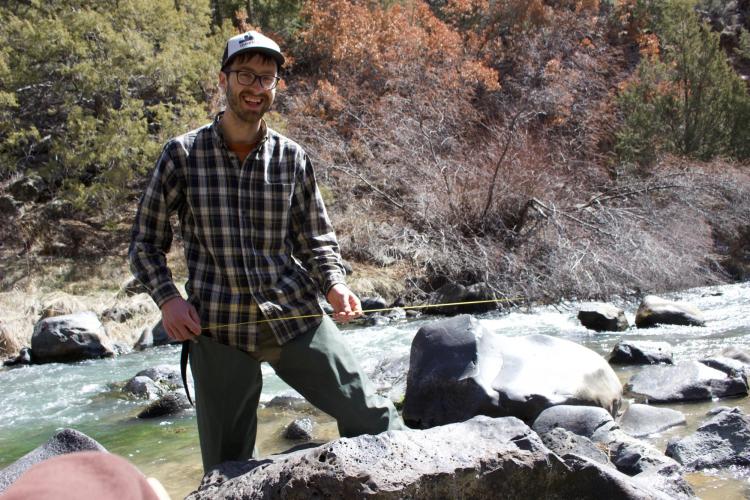Large Boulders help shape huge canyons, researchers find
CU Boulder geology grad students show how boulders influence canyon formation
Anyone who enjoys whitewater rafting in places like the Colorado River owes a debt of gratitude to the enormous boulders that create the foaming undulation known as rapids, and new research appears to shed more light on how these big rocks help shape the towering canyons around them.

CU Boulder researcher Charles M. Shobe
Charles M. Shobe and Rachel C. Glade, geology graduate students at the University of Colorado Boulder, argue in an article recently published online in the prestigious journal Geology—and scheduled for publication in print in July 2019—those same rocky monoliths play a major role in the geologic evolution of such canyons across vast spans of time—perhaps even more than the channels themselves.
“Our results imply that the existing, channel-driven models for canyon evolution may be overly simplistic, even when canyons evolve under a steady external forcing,” they write.
“People have been interested in river canyons for a long time, how they control the landscape and erosion,” says Glade, whose research focuses on the geomorphology of canyon walls and who completed her PhD last month. “But there is not a lot of understanding about how they work physically.”
The paper is co-authored by the pair’s faculty advisors, Distinguished Professor of Geology Robert Anderson and Professor of Geology Greg Tucker.

CU Boulder researcher Rachel C. Glade
Shobe and Glade created a computer model to understand the complex, two-way interplay between river-bottom boulders and hillsides to determine the course of canyon evolution.
Rivers that flow through “soft” geological formations tend to be wide and flat, like the Mississippi or South Platte. But rivers that flow across “resistant rock formations”—those with hard “caprock” in the upper layers—tend to form narrow canyons with steep upper hillsides. From a bird's eye view, canyon rims—the cliffs marking the canyon edge—form a bell shape as the canyon widens downstream.
Initially, erosion will carry sediment downstream, eventually loosening large blocks that tumble into the river below. At first, the presence of such blocks tends to slow the process of erosion, which in turn makes hillsides less steep.
“You can see that the bigger the blocks are, the more pronounced the bell shape of the canyon,” Glade says. “The big blocks slow down a canyon’s ability to erode over time and play a major role in changing canyon shape.”
However, Shobe and Glade’s model showed that rather than simply slowing down the process, the presence of large boulders in the channel created a feedback loop with steep hillsides, resulting in an oscillating rate of erosion and canyon evolution.
“This interplay between channel and hillslope dynamics results in highly variable long-term erosion rates,” they write.
While they can definitely move in large floods, when they are big enough, they can sit there for hundreds to thousands of years. That’s why the size of boulders is so important in shaping rivers.
“The prediction is, if intrinsic features of rock layers govern eventual shape, then the larger pieces the rock fractures into”—generally speaking, the harder the rock, the larger the block—“the more bell-shaped the canyon is going to end up and the more unpredictable the erosion dynamics will be,” Shobe says.
This spring, the pair were given an opportunity to field-test the model’s predictions, courtesy of a grant from the Geological Society of America. They traveled to northern New Mexico where they used a drone to photograph canyon walls and boulders in Rio Grande, and are now in the process of creating a 3D map of the area surveyed.
They are testing one of their main model predictions: “The size of the boulders corresponds to the steepness of the canyon walls,” Glade says. “If there’s a pile of big boulders, the steeper the walls should be.”
The model allows for the movement of blocks downstream at times of higher flow, but the researchers found erosion marks in the field indicating that boulders have been wedged in place for a long time.
“While they can definitely move in large floods, when they are big enough, they can sit there for hundreds to thousands of years,” Shobe says. “That’s why the size of boulders is so important in shaping rivers.”
Shobe and Glade write that these “channel-hillslope dynamics” are significant enough to outweigh other factors, such as the rate of geologic uplift, “calling into question the ability of landscapes to record tectonic and climatic signals or to reach a steady state during this time.
Better understanding how canyons with resistant rock formations are formed has implications beyond geology, Shobe says.
“The erosion and breakdown of rock is intimately connected with the climate cycle and the balance of CO2 in the earth’s atmosphere. The rates at which rock is eroded, and sediment is transported, is tied to the climate cycle as well as the long-term evolution of biodiversity,” he says.
It is uncommon for two PhD candidates to publish ground-breaking new research in a prestigious journal.
“We’re really pleased,” Shobe says. “This collaboration shows that two grad students can get together and come up with something new and unique while learning to collaborate as early-career scientists.”

